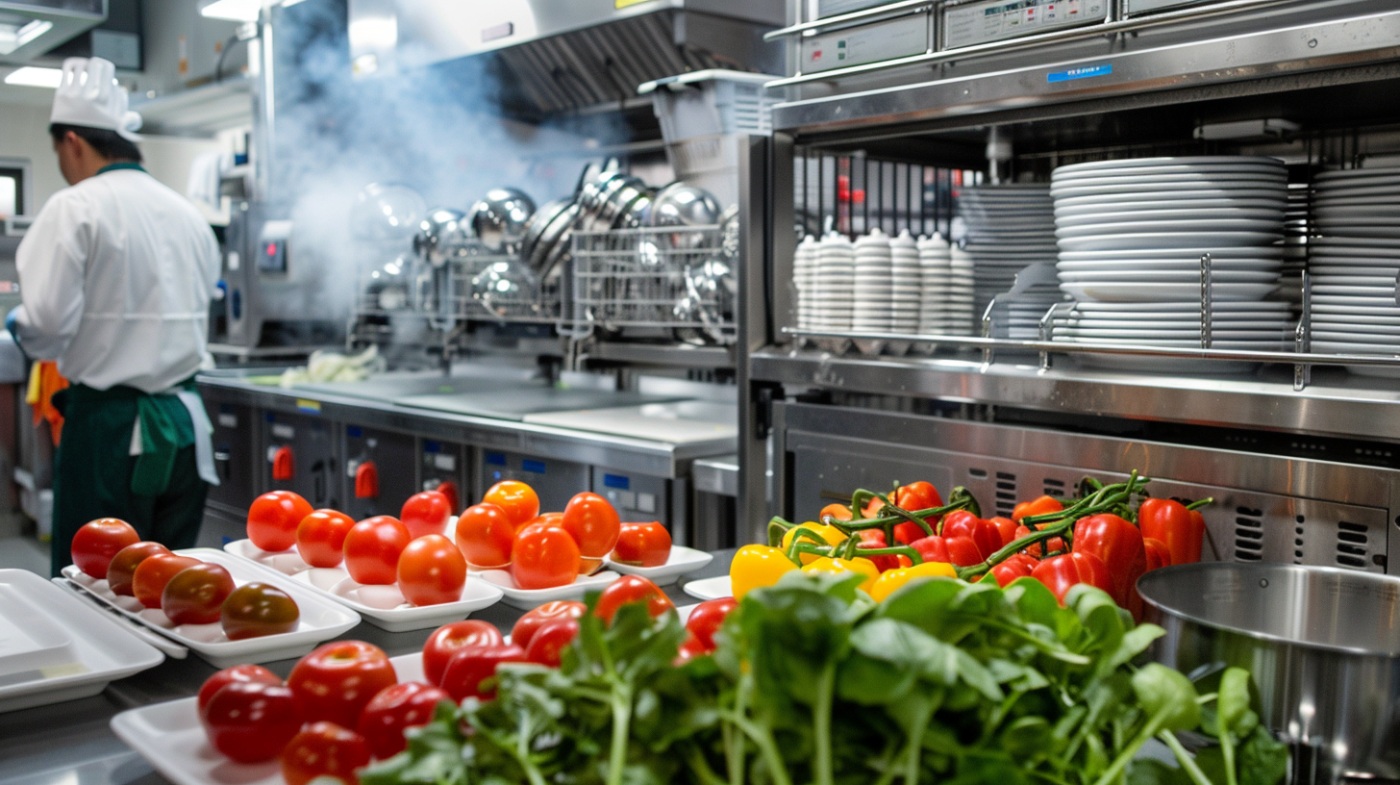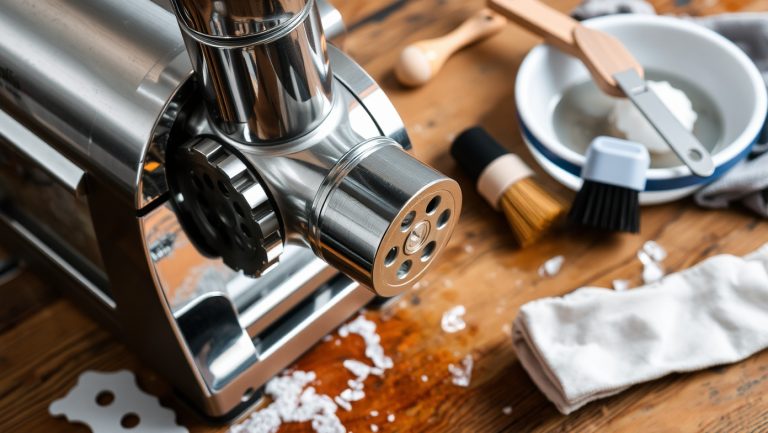How to Use a Commercial Dishwasher: Expert Tips
To use a commercial dishwasher effectively, start with pre-operation checks; verify detergent levels and confirm the drain valve is closed. Scrape food remnants and pre-rinse items to aid cleaning. Load dishes strategically, grouping similar items, and place heavily soiled ones facing the spray arms.
Power on the machine and select the appropriate wash cycle based on soil levels. Close all doors during operation to maintain temperature. After washing, conduct daily maintenance by cleaning filters and interior surfaces. By following these steps, you’ll optimize cleaning and confirm your equipment runs smoothly; you’ll discover more tips on enhancing efficiency.
Key Takeaways
- Perform pre-operation checks, including verifying detergent levels and ensuring the drain valve is closed before starting the dishwasher.
- Scrape and pre-rinse utensils to remove food particles and enhance cleaning efficiency.
- Load items properly by grouping similar items, positioning glassware upside down, and ensuring heavily soiled dishes face the spray arms.
- Select appropriate wash cycles based on soil levels, keeping all doors closed during operation to maintain temperature.
- Conduct daily maintenance by cleaning spray pipes, wiping down surfaces, and monitoring machine components for optimal performance.
Pre-Operation Checks
Before you operate a commercial dishwasher, it’s essential to routinely perform a series of pre-operation checks to guarantee peak performance and safety.
Start by consulting any QR codes, manuals, or wall manuals specific to your machine model. This verifies you’re following the correct procedures tailored for your equipment.
Next, check the detergent and rinse aid containers. Make sure they’re properly connected and filled to achieve effective cleaning results. Insufficient detergent can compromise the wash quality, while low rinse aid levels can lead to unsightly streaks on dishes.
Another important step is to verify that the drain valve is securely closed. This prevents leaks and maintains operational efficiency when you fill the machine with water.
Additionally, inspect the interior of the dishwasher to confirm that it’s clean and empty, with no loose parts that could lead to contamination during the wash cycle.
Lastly, adhere to all safety protocols. Wear appropriate personal protective equipment to minimize risks while operating the dishwasher.
Starting the Machine
Once you’ve completed your pre-operation checks, you can proceed to start the machine. First, verify that the wash tank grid and basket wheel are correctly placed, and confirm that all doors and the drain valve are securely closed.
Activate the main electrical switch to power on the machine, and take a moment to review the manufacturer’s instructions for any specific setup details.
Next, use the control panel to select the water-filling option. This will allow the machine to fill with water and heat it to the required ideal temperature, which may take between 10 to 30 minutes, depending on your model.
It’s essential to wait until the machine has achieved this temperature before you proceed. During this time, keep an eye on the indicators to confirm that the ideal temperature for washing is reached.
Once the machine is ready, you’ll be set to initiate the wash cycle. This preparation guarantees that your utensils and wares will be cleaned efficiently and effectively, maximizing the performance of your commercial dishwasher.
Preparing Utensils and Wares
Preparing utensils and wares for the commercial dishwasher is vital for achieving excellent cleaning results. Begin by scraping off food remnants from all items, as this prevents clogging and guarantees peak cleaning. For plates and crockery, use a pre-rinse shower set below 45 °C to effectively remove grease and food particles, enhancing the wash cycle’s efficiency.
For heavily soiled items, soaking and scrubbing before washing can help loosen stubborn residues. Group similar items together for efficient loading, which maximizes water circulation and improves cleaning effectiveness.
Here’s a quick guide to help you prepare your utensils and wares:
| Preparation Step | Purpose |
|---|---|
| Scrape food remnants | Prevent clogging and enhance cleaning |
| Pre-rinse under 45 °C | Remove grease and food particles |
| Soak and scrub | Loosen stubborn residues |
| Group similar items | Maximize water circulation |
| Avoid untreated protein stains | Prevent permanent damage and improve results |
Loading Techniques
When loading your commercial dishwasher, proper item arrangement is key to achieving ideal cleaning results.
Make certain to group similar items and position heavily soiled surfaces toward the spray arms, while avoiding overcrowding to guarantee water can circulate freely.
This approach not only enhances cleaning efficiency but also helps prevent overloading issues that can lead to damage or incomplete washes.
Proper Item Arrangement
Effective loading techniques are essential for achieving ideal cleaning results in a commercial dishwasher. Start by ensuring proper item arrangement; group similar items like plates, glasses, and utensils in designated wash racks. This maximizes water circulation and promotes superior cleaning efficiency.
Avoid overcrowding the racks; adequate spacing is vital for effective circulation of water and detergent. This prevents blockages of spray arms, which can hinder cleaning performance.
When loading glassware, position it upside down to allow for proper drainage, and place flatware with handles facing down to prevent water pooling inside.
For heavily soiled dishes, face them toward the spray arms. This positioning allows for better exposure to water and detergent, enhancing cleaning effectiveness.
Additionally, securely place all items in the racks to prevent movement during the wash cycle. Items that shift can lead to ineffective cleaning and potential damage.
Preventing Overloading Issues
Maintaining ideal efficiency in a commercial dishwasher hinges on preventing overloading issues during the loading process. To achieve maximum cleaning efficiency, you should adopt proper loading techniques that prioritize adequate spacing between items.
Group similar items—like plates, glasses, and utensils—together to promote best washing and prevent any obstruction of the spray arms. It’s similar to guaranteeing even baking in commercial ovens, where proper spacing is key to achieving consistent results, as seen in best practices for cake baking.
Be cautious not to place larger items outside of the designated wash racks, as this can block water spray and lead to inconsistent cleaning results. When loading, make certain that heavily soiled dishes face the spray arms; this positioning allows for the most effective cleaning during the wash cycle.
Regularly assess your loading patterns to enhance efficiency and minimize the risk of overloading. Overloading can damage the dishwasher and compromise the cleaning process, leading to unsatisfactory results.
Running Wash Cycles
Running wash cycles in a commercial dishwasher requires careful attention to the selected wash program, as this choice directly impacts the cleaning effectiveness. To get the best results, choose a program based on the soil level of the items. Heavily soiled dishes benefit from longer cycles, guaranteeing thorough cleaning. Avoid using the granule mode for crockery and plates, as it can lead to poor results and potential damage.
Once you’ve selected the appropriate wash cycle, press the start or confirm button. Be certain all doors are closed to maintain temperature and pressure during operation. Keeping doors closed between cycles helps conserve energy and guarantees the machine operates as efficiently as possible.
It’s essential to monitor the machine during the wash cycle. Look out for any error messages, as addressing these issues promptly can prevent disruptions in service.
| Soil Level | Recommended Wash Cycle |
|---|---|
| Lightly Soiled | Short Cycle |
| Moderately Soiled | Standard Cycle |
| Heavily Soiled | Long Cycle |
Daily Maintenance Routine
After completing the wash cycles, it’s crucial to implement a daily maintenance routine to keep the commercial dishwasher in peak working condition.
First, stop the machine and open the drain valve to empty the wash tank completely. This step prevents the buildup of residual water, which can lead to contamination.
Next, clean the spray pipes and filters thoroughly; this guarantees ideal water pressure and prevents clogs that could reduce cleaning efficiency.
Wipe down the interior surfaces, including the wash tank and door seals, to remove any grease or food particles that might cause hygiene issues.
Don’t forget to regularly inspect and clean the overflow sieve and granule valve cover to maintain proper filtration and avoid blockages.
Advanced Usage Tips
To achieve the best results with your commercial dishwasher, tailor your approach based on the specific soil levels of the items being cleaned. Utilize appropriate wash cycles for varying levels of soil, as heavier food residue requires longer wash times for ideal sanitation. Implementing a pre-rinse process can greatly reduce the soil load, enhancing cleaning efficiency and preserving the machine’s functionality.
Regularly inspect and clean spray arms to prevent blockages that hinder water distribution, guaranteeing effective washing. Monitor water temperature settings, ideally maintaining between 140-160°F, to activate detergents efficiently and guarantee proper sanitization during the wash cycle.
Here’s a quick reference table for soil levels and wash cycles:
| Soil Level | Recommended Wash Cycle |
|---|---|
| Light Soil | Quick Wash |
| Medium Soil | Standard Wash |
| Heavy Soil | Extended Wash |
| Extremely Heavy Soil | Pre-Wash + Heavy Cycle |
Additionally, keep a maintenance log to track servicing and any irregularities. This habit guarantees timely interventions for ideal machine performance, maximizing the effectiveness of each wash and rinse cycle.
Frequently Asked Questions
How to Use a Commercial Kitchen Dishwasher?
Before you begin, verify everything’s in order; check cleanliness, containers, and cycle selection. Carefully load dishes, scrape remnants, and monitor maintenance. This attention to detail assures efficient, effective, and hygienic dishwashing results every time.
How Do Commercial Dishwashers Work?
Commercial dishwashers heat water to 140-160°F and spray it mixed with detergent onto dishes. They operate in cycles of 2 to 5 minutes, ensuring effective cleaning by optimizing loading and maintaining equipment regularly.
How Do I Turn on the Restaurant Dishwasher?
To ignite the restaurant dishwasher’s operation, guarantee it’s empty, check connections, secure the drain valve, and power it on. Select the water-filling option, allowing it to heat before use. Follow your model’s instructions closely.
Do Commercial Dishwashers Need Detergent?
Yes, commercial dishwashers need detergent to effectively remove food residues and sanitize dishes. Choose high-quality detergents tailored to your water hardness, monitor levels regularly, and select between liquid or solid based on your operational needs.
Elevate Your Kitchen Workflow with Expert Dishwasher Practices
To sum up, using a commercial dishwasher is about precision, efficiency, and care. You’ll check the machine, load it properly, and run cycles effectively. You’ll maintain it daily, ensuring it stays in top shape.
With the right techniques and attention to detail, you’ll transform dirty dishes into sparkling clean utensils, creating a seamless workflow in your kitchen. Embrace these practices, and watch your operations shine just like the wares you serve.







